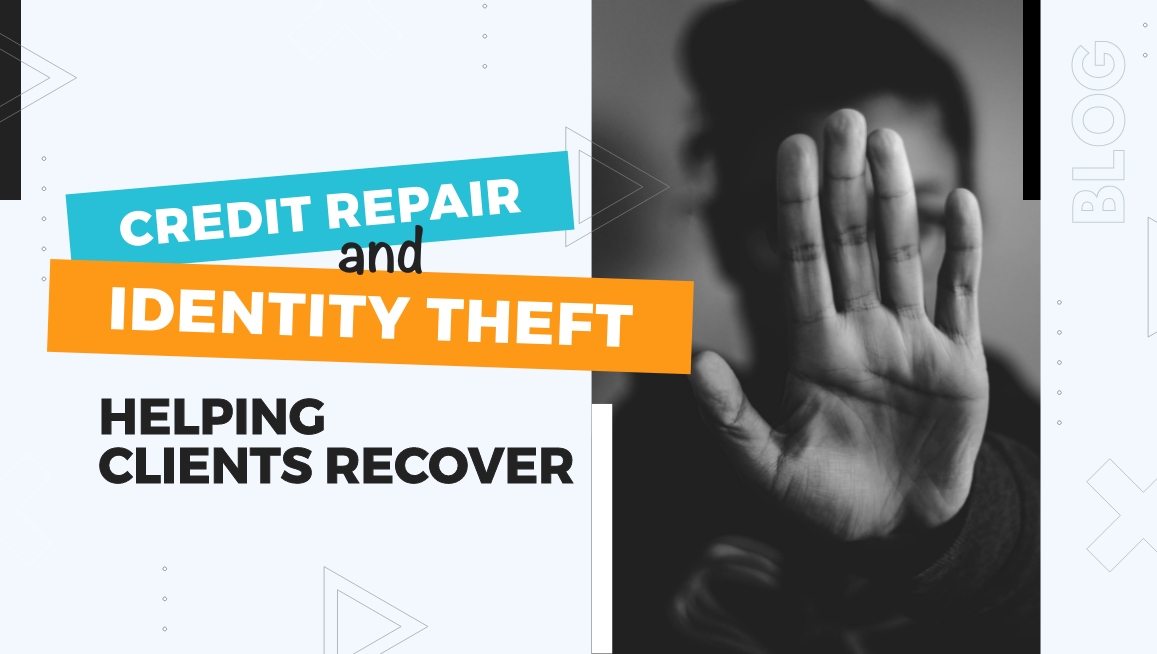Credit Repair and Identity Theft: Helping Clients Recover
by Almas Tariq
July 17, 2024
03:10 PM

The credit repair industry plays a pivotal role in helping individuals restore their financial health by addressing inaccuracies on their credit reports. This sector is not just about fixing errors; it involves a comprehensive approach to ensure that clients can achieve a clean financial slate. One significant challenge that credit repair businesses frequently encounter is identity theft. Identity theft is a growing concern, affecting millions of individuals worldwide. It involves the unauthorized use of someone’s personal information, such as Social Security numbers, credit card details, or other financial data, usually for financial gain.
The consequences can be devastating, leading to fraudulent accounts, massive debts, and significantly lowered credit scores. For credit repair businesses, offering comprehensive identity theft recovery services is essential. These services help clients regain control of their financial lives, rebuild their credit, and prevent future occurrences. This blog will explore the various aspects of credit repair and identity theft recovery, providing detailed insights and practical steps for credit repair businesses to effectively assist their clients.
Understanding Identity Theft and Its Impact on Credit
Identity theft is the fraudulent acquisition and use of a person’s private identifying information, usually for financial gain. It is a pervasive issue that can have devastating effects on an individual’s credit report and overall financial stability.
Definition: Identity theft occurs when someone unlawfully obtains and uses another person’s personal data, such as Social Security numbers, credit card details, or other financial information, typically to commit fraud. This criminal act can happen through various means, including phishing scams, data breaches, or even physical theft of mail and personal documents.
Types of Identity Theft:
-
Financial Identity Theft
Financial identity theft is the most common type of identity theft. It occurs when someone uses another person’s financial information, such as credit card numbers or bank account details, to make unauthorized purchases or withdrawals. This type of theft can quickly lead to significant financial losses for the victim. For example, a thief might open new credit accounts in the victim’s name, max out the credit limits, and leave the victim with substantial debts that they are unaware of until the bills arrive. The immediate financial burden can be overwhelming, and the long-term impact on the victim’s credit score can make it difficult to obtain loans, mortgages, or even employment.
-
Medical Identity Theft
Medical identity theft involves using someone else’s personal information to receive medical services or obtain drugs. This type of theft can result in erroneous medical records, incorrect treatments, and substantial financial charges for the victim. For instance, an identity thief might use the victim’s insurance information to receive expensive medical treatment or prescription drugs. The victim may only discover the theft when they receive bills for medical services they did not receive or when they are denied insurance coverage due to conditions they do not have. The impact on the victim’s health records can be severe, leading to incorrect treatments or missed diagnoses.
-
Criminal Identity Theft
Criminal identity theft happens when someone uses another person’s identity when apprehended for a crime. This can lead to wrongful criminal records and legal complications for the victim. For example, if a thief is arrested and provides the victim’s personal information to law enforcement, the victim may end up with an arrest record and criminal charges that can affect their personal and professional life. Clearing one’s name can be a lengthy and stressful process, involving court appearances and legal fees.
-
Synthetic Identity Theft
Synthetic identity theft involves combining real and fake information to create a new identity. This type of theft is particularly challenging to detect and can lead to long-term financial harm for the victim. For instance, a thief might use a combination of real Social Security numbers with fabricated personal details to create a new, fraudulent identity. This synthetic identity can then be used to open bank accounts, apply for credit cards, and even secure loans. Because the identity is partially fabricated, it can be difficult for victims to prove that they have been wronged, and the fraudulent activities may go undetected for extended periods.
Impact on Credit:
- Lowered Credit Scores: Identity theft can lead to multiple fraudulent accounts and high balances, significantly lowering the victim’s credit score. When fraudulent accounts go unpaid, they are reported as delinquent, causing a substantial drop in the credit score. This can affect the victim’s ability to obtain credit in the future and may result in higher interest rates on loans and credit cards.
- Fraudulent Accounts: Fraudsters may open new accounts in the victim’s name, leading to increased debt and financial liabilities. These accounts can include credit cards, loans, and even utilities and phone services. The victim often remains unaware of these accounts until they start receiving collection notices or their credit report shows accounts they did not open. The financial burden of these fraudulent accounts can be overwhelming and disputing them can be a time-consuming and stressful process.
- Difficulty Obtaining Loans: A damaged credit score makes it challenging for victims to secure loans, mortgages, or even employment. Many lenders, landlords, and employers check credit reports as part of their evaluation process. A poor credit score resulting from identity theft can lead to loan denials, higher insurance premiums, and missed job opportunities. The long-term financial implications can be severe, making it essential for victims to address identity theft promptly and effectively.
Role of Credit Repair Businesses:
Credit repair businesses are crucial in helping victims of identity theft. Their responsibilities include:
- Correcting Inaccuracies: Identifying and disputing fraudulent entries on credit reports is a primary task for credit repair businesses. This involves thoroughly reviewing the client’s credit reports from all three major credit bureaus (Equifax, Experian, and TransUnion) and pinpointing unauthorized accounts and transactions.
- Educating Clients: Providing information on how to protect against future identity theft is equally important. Credit repair businesses should educate clients about the importance of monitoring their credit reports regularly, using strong and unique passwords for online accounts, and being cautious about sharing personal information.
- Preventing Future Occurrences: Implementing strategies and advising clients on best practices to safeguard their personal information helps prevent future incidents. This can include recommending credit monitoring services, placing fraud alerts on their credit reports, and taking steps to secure personal documents and digital information.
The Role of Credit Repair Businesses in Identity Theft Recovery
When a client approaches a credit repair business after falling victim to identity theft, it is essential to take immediate and effective steps to address the situation.
Initial Steps:
-
Client Consultation
The first step in the recovery process is conducting a thorough consultation with the client. This consultation aims to understand the extent of identity theft, gather detailed information about the fraudulent activities, and assess their impact on the client’s credit. During this consultation, the credit repair specialist should ask the client about any suspicious activities they have noticed, review any documentation they can provide, and explain the steps that will be taken to address the issue. This initial meeting sets the foundation for a successful recovery process and helps build trust between the client and the credit repair business.
-
Obtaining Credit Reports
The next step is to obtain credit reports from all three major credit bureaus (Equifax, Experian, and TransUnion). Analyzing these reports is crucial to identify fraudulent accounts and inaccuracies. Credit repair businesses should look for accounts the client does not recognize, inquiries from unfamiliar creditors, and any discrepancies in personal information. This comprehensive review helps in creating a clear picture of the extent of the identity theft and lays the groundwork for the dispute process.
-
Identifying Fraudulent Activities
Once the credit reports are obtained, the next step is to identify unauthorized transactions, accounts, and personal information changes. Creating a detailed list of all the fraudulent activities and their specifics is essential for drafting effective dispute letters and communicating with creditors. This list should include account numbers, transaction dates, amounts, and any other relevant information. By systematically identifying and documenting fraudulent activities, credit repair businesses can ensure that no detail is overlooked in the recovery process.
Action Plan:
-
Disputing Fraudulent Items
Drafting dispute letters to credit bureaus is a critical part of the recovery process. These letters should challenge the fraudulent items on the client’s credit report and provide evidence to support the claims. Evidence can include police reports, identity theft affidavits, and any other documentation that substantiates the client’s case.
Tailor each dispute letter to the specific credit bureau and include detailed explanations of the fraudulent activities. Clearly demonstrate that the disputed items are not the client’s responsibility and should be removed from their credit report.
-
Working with Credit Bureaus
Maintaining communication with credit bureaus is essential to ensure timely processing of disputes. Credit repair businesses should follow up regularly to check the status of the disputes and ensure they are being addressed promptly. This involves calling the credit bureaus periodically, sending follow-up letters if necessary, and keeping detailed records of all communications. Consistent follow-up ensures timely resolution of disputes and prevents delays in the recovery process.
-
Contacting Creditors
In addition to disputing items with credit bureaus, reach out to creditors about the identity theft. Request that they close fraudulent accounts. Provide creditors with documentation to support the claim. Work with them to remove fraudulent accounts from the client’s credit history. Send letters to each creditor explaining the situation. Request immediate action to address the fraudulent accounts. Follow up as needed to ensure the accounts are closed. Resolve any associated debts.
Importance of a Robust CRM:
A robust Credit Repair CRM (Customer Relationship Management) system is vital for tracking cases, managing communications, and ensuring timely follow-ups. A good CRM system helps in organizing client information, automating reminders, and maintaining detailed records of all actions taken.
Document all steps, conduct timely follow-ups, and ensure no details are overlooked for effective identity theft recovery. Use a CRM system to manage client communications, provide updates on the status of disputes, and keep clients informed throughout the recovery process.
Effective Credit Repair Dispute Processing
Dispute processing is a critical component of credit repair. Proper dispute handling can remove fraudulent items and significantly improve the client’s credit score. This process involves several detailed steps, each requiring careful attention and thorough documentation.
Process:
- Gathering Evidence: The first step in the process is collecting all necessary documentation to support the dispute. This includes obtaining copies of police reports, identity theft affidavits, and other relevant evidence substantiating the client’s claim. The more comprehensive the documentation, the stronger the dispute case will be. Credit repair businesses should work closely with clients to gather all possible evidence and ensure that it is organized and readily available for submission.
- Drafting Dispute Letters: Creating clear and concise dispute letters is essential for effectively challenging fraudulent items on the client’s credit report. These letters should outline the fraudulent items in question and provide detailed evidence to support the claim. Each dispute letter should be tailored to the specific credit bureau and creditor, addressing the unique aspects of the fraudulent activity. The letters should clearly explain why the disputed items are not the client’s responsibility and request their removal from the credit report.
Table of Contents
Explore More Insights
Dive deeper into a wealth of knowledge. Discover a multitude of articles covering diverse topics, expert perspectives, and the latest trends. Feed your curiosity and expand your understanding.


![Is a 650 Credit Score Good or Bad? What to Tell Clients [+ Action Plan for Credit Repair Pros]](https://scoreceo.com/wp-content/uploads/2025/11/Image-of-650-Credit-Score-Blog-370x250.jpg)
